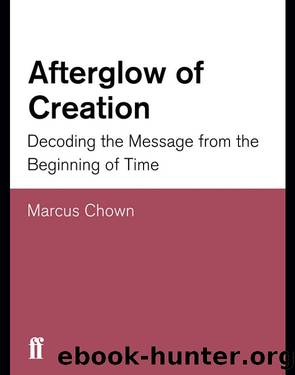Afterglow of Creation by Marcus Chown

Author:Marcus Chown [Marcus Chown]
Language: eng
Format: epub
ISBN: 9780571250608
Publisher: Faber & Faber
Published: 1993-06-15T00:00:00+00:00
The Birth of Galaxies
But what was destined to become an embarrassment was the fact that apart from the âdipoleâ variation, the cosmic background radiation seemed utterly smooth across the sky. âWe knew the radiation had to be smooth,â says Jim Peebles, âbut we knew it could not be dead smooth because todayâs Universe is lumpy.â
At some point the smoothly distributed matter in the early Universe had to start clumping to form galaxies and clusters of galaxies, and this should make itself visible as an unevenness in the cosmic background radiation.
Back in 1965, when Bob Dicke had first introduced him to the idea of a hot Big Bang, Peebles had realised that the fireball radiation was linked with the origin of galaxies such as the Milky Way. âIt was pretty evident that the radiation would have an important effect on how galaxies form,â says Peebles.
The fireball radiation completely dominated the Universe during the first 380,000 years after the Big Bang. For every particle of matter, there were about 10 billion photons, a ratio which has remained constant in the Universe to this day. But though todayâs background photons have been cooled and diluted by the expansion of the Universe, in the early Universe the photons were immensely hot and packed closely together. This meant that in any cubic centimetre of the early Universe the total energy of the photons was enormously greater than the energy of the particles of matter. Matter was only a minor contaminant. In the early Universe, radiation called the shots.
The implication of all this for galaxy formation is that the process could not begin earlier than 380,000 years after the Big Bang. Any particles that came together would simply be blasted apart by photons of the fireball radiation. But after 380,000 years, atoms formed and mopped up all the free electrons through which the photons of the fireball radiation were influencing matter. The Universe became transparent to photons, and from that moment on matter and radiation went their separate ways.
Coincidentally, this was also roughly the time when the energy density of radiation in the Universe dropped below that of matter. This happened because the energy of photons was diluted as their wavelength was stretched by the expansion of the Universe. But the energy density of particles of matter cannot be diluted indefinitely because each particle has a floor â a so-called rest energy â below which it cannot go.2
So, about 380,000 years after the Big Bang, the Universe became dominated by matter. Freed from the tyranny of radiation, matter could begin to clump under the force of gravity. Gravity, not the pressure of radiation, was now the dominant force in the Universe.
Because the photons of the cosmic background radiation last interacted with matter around this time, they ought to reveal how matter was spread throughout the Universe back then. As early as 1968, the theorist Joseph Silk had pointed out that mapping the temperature of the cosmic background radiation would allow us to âseeâ clumps of matter 380,000 years after the Big Bang, just as the process of galaxy formation was beginning.
Download
This site does not store any files on its server. We only index and link to content provided by other sites. Please contact the content providers to delete copyright contents if any and email us, we'll remove relevant links or contents immediately.
Tools of Titans by Timothy Ferriss(7735)
Turbulence by E. J. Noyes(7660)
Astrophysics for People in a Hurry by Neil DeGrasse Tyson(4972)
Secrets of Antigravity Propulsion: Tesla, UFOs, and Classified Aerospace Technology by Ph.D. Paul A. Laviolette(4860)
Design of Trajectory Optimization Approach for Space Maneuver Vehicle Skip Entry Problems by Runqi Chai & Al Savvaris & Antonios Tsourdos & Senchun Chai(4806)
Room 212 by Kate Stewart(4703)
Pale Blue Dot by Carl Sagan(4573)
The David Icke Guide to the Global Conspiracy (and how to end it) by David Icke(4348)
A Journey Through Divination and Astronomy by Publishing Pottermore(4233)
Apollo 8 by Jeffrey Kluger(3481)
Goodbye Paradise(3413)
Losing the Nobel Prize by Brian Keating(3409)
COSMOS by Carl Sagan(3313)
The Five People You Meet in Heaven by Mitch Albom(3295)
Brief Answers to the Big Questions by Stephen Hawking(3218)
How to Read Water: Clues and Patterns from Puddles to the Sea (Natural Navigation) by Tristan Gooley(3210)
The Order of Time by Carlo Rovelli(3052)
How to Read Nature by Tristan Gooley(3048)
A Brief History of Time by Stephen Hawking(2795)
